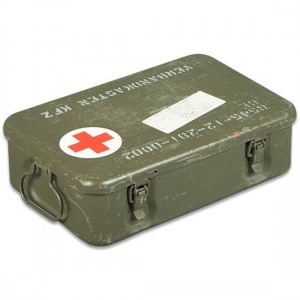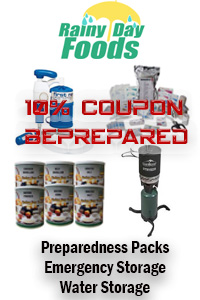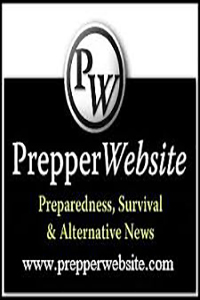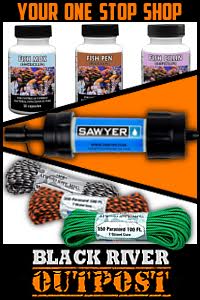 I was recently over at GA’s website, Survive2balive.com and read a post about a few of the medical supplies he recommended for everyday first aid. This got me thinking about my own medical supply plan, how I got started and eventually improved it. I think it is very important to have a wide range of medical supplies for any number of scenarios that could occur on a daily basis or after SHTF, but there are also other factors out there which must be considered in order to make your entire medical plan complete. Simply buying a decent first aid kit and tossing it on your basement shelf is about the worst thing you can do, slightly above not owning a first aid kit at all. Medical preparedness must be taken seriously in order to increase your chances of survival.
I was recently over at GA’s website, Survive2balive.com and read a post about a few of the medical supplies he recommended for everyday first aid. This got me thinking about my own medical supply plan, how I got started and eventually improved it. I think it is very important to have a wide range of medical supplies for any number of scenarios that could occur on a daily basis or after SHTF, but there are also other factors out there which must be considered in order to make your entire medical plan complete. Simply buying a decent first aid kit and tossing it on your basement shelf is about the worst thing you can do, slightly above not owning a first aid kit at all. Medical preparedness must be taken seriously in order to increase your chances of survival.
Planning considerations.
I’ve written about how buying a gun requires extensive planning, in that you always should consider what you will use the gun for before making your purchase. The same planning process holds true for selecting your medical supplies and forming your medical (emergency) plan. This planning process should rank right up there with how much guns and ammo or food supplies you have on site but unfortunately medical preparedness is quite often overlooked because it isn’t as sexy as the aforementioned topics.
In order to effectively plan you need to consider what scenarios you will encounter during which you will have to employ anything from your medical kit. In most instances wounds post SHTF will be of that minor variety, simple cuts and abrasions, twisted ankles or back spasms. People operating outside and doing physical labor when they aren’t used to it. Nothing a bottle of Aspirin, some Icy Hot, topical antibiotic cream and gauze won’t be able to cure. There are slight chances that larger or more life threatening wounds could occur and in those instances you will need to ask yourself if you are even qualified to treat injuries of that nature. What good is owning a field surgical kit if the most you have ever done is apply an ACE wrap to a sprained ankle? Do you really think that if someone in your family gets shot or almost hacks their leg off accidentally while chopping wood that you’ll simply be able to flip to your handy “how to operate on people” surgical guide and fix them right up? Don’t kid yourself. While it might not be a bad idea to own a surgical kit it would be an even better idea to establish personal relationships with (at minimum) your family doctor and family vet (if you have pets). Also know exactly where the closest medical facilities are to your home and how to get there without a map (read: GPS). Try to network in your local area and make friends with surgeons or at minimum EMTs who are used to treating trauma victims. All of these relationships could end up being life saving if SHTF and you absolutely need to find someone with the capability to tend to the wounds I listed above.
Buying Supplies
You’ve planned for your scenarios and know what you are capable of and where to go if you encounter situations beyond your control. Let me be clear in that just because you do not know how to conduct a field operation does not mean you shouldn’t own some equipment related to surgery. Maybe in a post SHTF environment the hospitals are overwhelmed or shut down but you still can get your friend the surgeon over to your home and provide him or her with the rudimentary supplies to help save someone’s life. Keeping that in mind let’s take a look at some basic supplies which you should consider owning, this is not an all inclusive list by any means.
- Emergency Medical Kit. Lots of great and useful products in kits like these and because there are so many supplies you will have extra for bartering purposes if need be.
- Burn Gel. While a couple packets probably come in your base emergency kit (see above) it’s always great to have more.
- Suture kits. Cheap and relatively easy to use, kits like these can be employed with minimal training and are effective in sewing up small cuts.
- Steri Strips. Another way to keep small wounds closed
- Isopropyl Alcohol. Used to clean and prevent infection in minor cuts and scrapes
- Hydrogen Peroxide. Cleans wounds and helps guard against infection
- Poison Ivy Treatment. Nobody wants to get stricken with a bad case of poison ivy/poison oak. Something as simple as an extra supply of this on hand can make life so much more manageable.
- Quik Clot: Great for stopping the bleeding associated with a big trauma wound. Think of this as something which will buy you time so that you can find a real Doctor.
- Surgical gloves. Sterility is key, these should be worn at all times when treating wounds.
- Israeli Bandages. Also used the stop bleeding and have the capability of becoming a pressure dressing when knotted down correctly.
- Field surgical kit. Always nice to own for those absolute worst case scenarios, as previously mentioned make sure you know someone who can actually use the kit safely.
- IV Kits with all accessories. From treating extreme dehydration to actual small time surgical procedures these kits are essential to own. Learning how to insert a needle/catheter is really not that hard but does require practice.
- Stapler kits. Compliment to the surgical kit, not to be used by untrained people unless no other option exists.
- Field tourniquets. For serious wounds where the patient is in danger of bleeding out before medical treatment is reached.
- Splints. Great to have when treating broken bones (non-compound) or sprains. Better than using a stick.
- Emergency Dental Kit. Last but certainly not least, it is essential to own one of these kits. Many a strong man have gone down over tooth related pain. Obviously the best method is prevention (i.e. good dental hygiene) but a kit like this could become indispensable
Skills / Knowledge.
Once you have a plan and have made a nice list of supplies the final phase is to acquire some reference material and knowledge. Think of it as adding to your SHTF capabilities and your medical library which you can refer to when treating minor ailments, wounds, or even conducting lifesaving steps which will buy you time to get your loved one to professional medical care. Even during times such as these where society is functional having some medical skills could pay huge dividends.
- Take a CPR class.
- Take a basic Trauma class if available in your area.
- Buy good reference material.









8 comments
Skip to comment form
Great List. Picking up a good minor surgery kit is a must. Even if you do not possess the skills and abilities to use it, there is a good chance that somebody nearby does.
I have acquired quite a few packets of DenTemp. It is a good product to have on hand in case you lose a filling, cap or crown.
Another item for consideration would be cold packs. They are realtively inexpensive and can come in quite handy for sprains and strains…they are also great for cooling down a drink if you’re desperate!
Thanks for the mention PJ, outstanding information as always!!!
Author
Excellent suggestion on the cold pack, will be great to have assuming there is power and a means with which to freeze the pack. I also forgot to add ACE bandages (wraps), but like I said the the is not all inclusive. 🙂
Thanks for the suggestions.
Where I’m from, we don’t usually get struck by hurricanes but we often have floods and storms, yearly. These preparation kits you’ve suggested are really good. The way I do it, I always see to it that I have a spare battery for a flashlight and I have piled a different batch of clothes into a bag so that when calamity hits our town, all I have to do is get the bag and the supplies I’ve prepared.
Author
Sarah, good point about the spare battery and being ready to leave quickly. Quite often this can mean the difference between getting ahead of the crush of traffic or stuck in the middle of it. I’m glad to see you are prepared.
Hi, PJ! Thanks for replying. The sad thing, though, is that there are few people who practice this. I grew up watching commercials and shows about being ready for calamities but others fail to follow. So, whenever something happens, they don’t come prepared.
Author
I agree Sarah, people often procrastinate and it comes back to bite them. Hopefully we can help to educate some of them via outlets like this website or even in person. I’m glad to hear that you are prepared, you are one of the few who “get it.” Thanks for your comment.
You’ve spent a day in the woods or a day doing yard work when you brush against the leaves of a poison ivy or poison oak plant. Or maybe you didn’t notice the plants, but you’ve developed a streaky rash with red bumps that turn into weeping blisters. You can treat the itchy allergic reaction that comes from exposure to poison ivy and poison oak resins with either drugstore remedies, home remedies or prescriptions corticosteroids. The rash may last from 1 to 3 weeks, but the symptoms usually peak between the fourth and seventh days.”,:’
Author
I am a poison ivy magnet! Usually when I do get it a shot in the butt from the hospital is the only thing that provides relief.